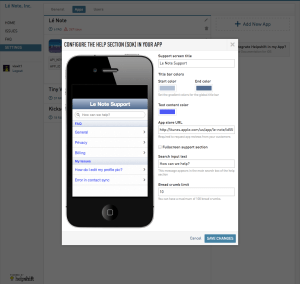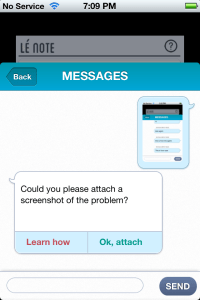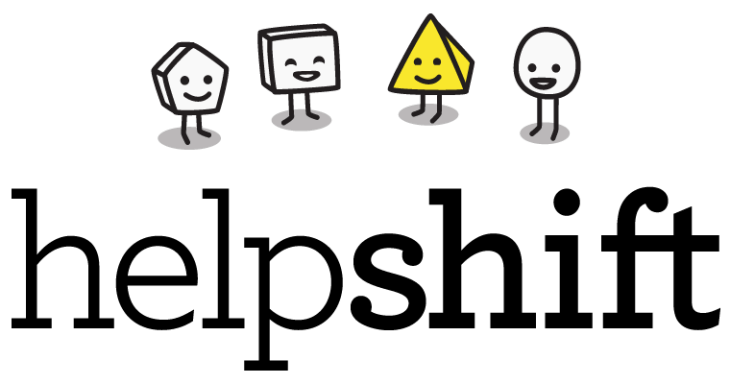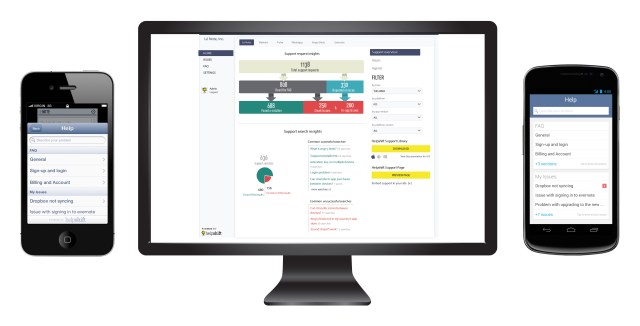When it comes to companies known for providing exceptional customer service, the list is short. Zappos comes to mind, but the truth is that the consumer has low expectations for companies in this regard, and that great customer service is an exception — not the norm. While players like Salesforce and Zendesk have helped shift the focus of CRM to the Web and social media, today, many startups and SMBs are adopting mobile-first development strategies for their businesses. Increasingly, that’s how their customers are interacting with their service — on mobile devices.
Last year, Abinash Tripathy and Baishampayan Ghose founded Helpshift to address what they perceived to be a significantly underserved market in customer service: Mobile. After months of testing their mobile solution, the startup is getting ready to pull the curtains back on its business and, to do that, it is today announcing that it has closed a $3.2 million round of seed financing, led by True Ventures and Nexus Venture Partners, with contributions from a number of private angel investors.
The financing will support the company’s soft launch of its mobile-focused, SaaS solution, which aims to be “the first embedded support desk for native apps,” allowing developers to capture device info from their users so that they can troubleshoot problems quicker and more effectively. Tripathy says that the startup’s goal is to enable businesses and development teams to be able to fix issues before they turn into “tickets” by offering built-in, self-service features.
To do so, Helpshift provides a native SDK that integrates with mobile apps to offer an “in app” customer experience that remains true to the look and feel of the app, rather than shoehorning its own design into each different mobile UX. Helpshift’s support screens can be customized to match the app’s visual style and is designed, the co-founder and CEO says, to be instantly searchable and available in offline mode, i.e. when a device isn’t connected to the network.
 Today, the solution offers support for iOS and HTML5 but, according to Tripathy, is “committed to being cross-platform” and will begin rolling out support for other mobile operating systems in the near future. Android support is slated to be added next week, he said.
Today, the solution offers support for iOS and HTML5 but, according to Tripathy, is “committed to being cross-platform” and will begin rolling out support for other mobile operating systems in the near future. Android support is slated to be added next week, he said.
In conversations with their early customers, the Helpshift founders consistently heard that the majority of their inbound customer inquiries were for common issues that already had solutions published on FAQ pages, for examples. The problem is that FAQs aren’t easily searchable or viewable given the smaller mobile form factor (in other words, smaller screens) so customers were opting to submit tickets instead of browsing through forums or FAQs to find answers on their devices.
Given this frequently occurring snag in the mobile customer experience, Helpshift wants to reduce the overall ticket volume and address the root of this problem, the CEO said, by allowing mobile developers to take advantage of proactive support. Nipping customer service problems in the bud, as it were.
In addition, the startup provides users with in-app mobile messaging functionality, enabling companies to communicate with their customers via short messages in a familiar chat-style. Device-specific diagnostics and screenshots can be sent inline within these messages, allowing customer service reps to address issues in realtime from Helpshift’s dashboard.
Noah Barr, who recently left Crittercism (a venture-backed AngelPad grad offering a performance-management solution for mobile developers) to head business development for Helpshift, tells TechCrunch that he sees a similar opportunity in mobile CRM as he does for mobile performance optimization. He said that even if big companies are thrown off by buzzwords or don’t immediately understand the use case in just asking them, “Do you have apps? Do you have have a customer support system for those apps?” most companies get it pretty quickly.
 There’s a lot of opportunity in the B2B mobile space, especially for those companies offering valuable on-demand mobile services to startups and SMBs — like Urban Airship, for example. Businesses large and small often don’t have the resources to build or offer a mobile-centric CRM solution for their apps, and it likely will cost them less to integrate third-party services than build it themselves. You could see this kind of mobile CRM service being attractive to game companies, allowing them to easily answer questions and provide documentation for gamers using their platforms.
There’s a lot of opportunity in the B2B mobile space, especially for those companies offering valuable on-demand mobile services to startups and SMBs — like Urban Airship, for example. Businesses large and small often don’t have the resources to build or offer a mobile-centric CRM solution for their apps, and it likely will cost them less to integrate third-party services than build it themselves. You could see this kind of mobile CRM service being attractive to game companies, allowing them to easily answer questions and provide documentation for gamers using their platforms.
As for the appeal for someone actually running a mobile-first business, Astrid founder and CEO Jon Paris tells us that, any way you slice it, mobile customer support is critical to avoid long, wandering emails and negative ratings in app markets. Being able to offer an FAQ that loads asynchronously so that already frustrated users don’t have to wait for a mobile website to load or struggle with slow search over spotty WiFi connections has value for any business trying to provide a consistent mobile (customer) experience.
Astrid had tried many support forums and tools but the problem with using WordPress (WPTouch) plugins, GetSatisfaction and others, he said, was that FAQ pages were slow to navigate and impossible to reach offline, so feature requests would get confused with bug reports, which became a mess to manage. Being able to offer type-in support requests from a mobile keyboard or to attach screenshots of bugs keeps feedback brief and to the point — and also visual (something anyone who has managed or used feedback can appreciate, he said).
“It’s allowed the Astrid team to focus on product insights and less on answering the same questions over and over again, and once they releases Android support, we’re migrating everything over to Helpshift,” Paris said.
More than a few mobile developers are justifiably worried that they’re missing a lot of feedback from customers who don’t even make it to the “Developer Support” page in iTunes — and many simply manage customer support for their products via labels in Gmail. By taking away some of the friction between end users and customer support teams and giving businesses and making it direct, Helpshift could help developers reduce the number of negative reviews and comments posted in app stores. And that right there is money in the bank.
More on Helpshift at home here.

